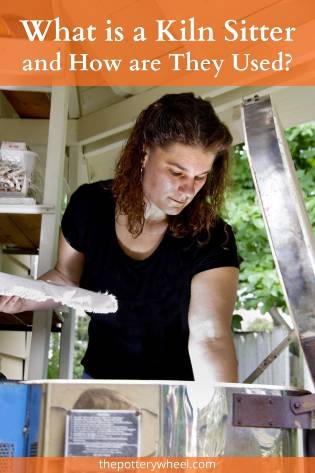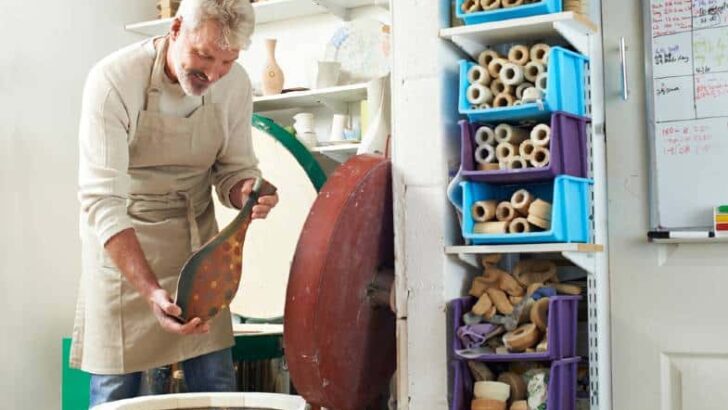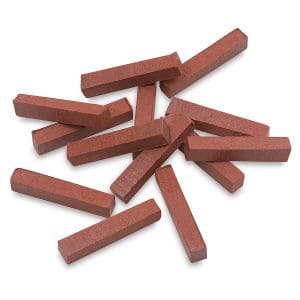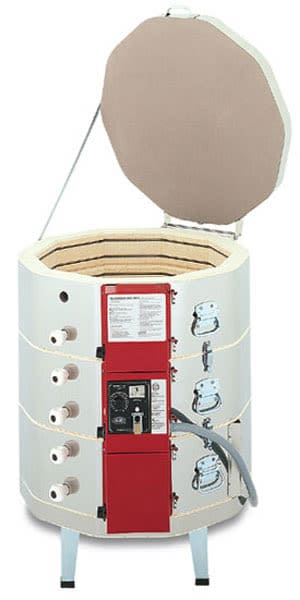When you are firing pottery in a kiln, you need to control the temperature that the kiln reaches. You also need to control how long it takes for the kiln to reach that temperature. So, what is a kiln sitter? There are three main types of kiln controller. They are the fully manual controller, the semi-manual controller, and the digital controller. A kiln sitter can be thought of as a semi-manual kiln controller.
Kiln sitters are mechanical devices that turn a kiln off after pottery has been fired. It uses a pyrometric cone to measure the temperature and time a kiln has taken to heat up. When the cone softens and bends, the kiln sitter turns off the power supply to the kiln.

What is a Kiln Sitter?
To understand how kiln sitters work, you need to understand a bit about heatwork. So, here is an overview of heatwork and kiln controllers….
Kiln Controllers and Heatwork
When clay is fired in a kiln, it matures. Mature clay is clay that has become as dense and strong as it can be. For clay to mature a kiln doesn’t just need to reach a particular target temperature. It also needs to have heated the clay for a certain length of time.
‘Heatwork’ is the term used by potters to talk about the temperature and time a piece has been fired. It is the amount of heat energy that a piece of pottery has received in the kiln. It is a combination of the temperature reached and the time that is taken to reach that temperature.
A kiln might reach a high temperature. However, if the temperature has climbed up too quickly, the clay may be underfired. This is because it hasn’t been hot for long enough.
Kiln controllers are designed to control the amount of heatwork your ceramics receive in the kiln
Kiln Sitter’s and Heatwork
A kiln sitter measures the heatwork that’s going on in a kiln using a pyrometric cone. Cones, also called Orton cones are small pieces of ceramic material that are designed to bend once they’ve had a particular amount of heatwork.
Often they are used by potters as a visual aid. The potter knows that once the cone has bent to a particular angle, then the pottery has had enough heatwork. There is a range of cones with different ratings, that bend according to different amounts of heatwork. Cones in that range are given different numbers. That’s why you will hear potters talking about a cone 6 firing, for example.
Pyrometric cones are a key part of how a kiln sitter works.
How Does a Kiln Sitter Work?
A kiln sitter is made up of a probe, or tube assembly, that goes through a hole in the side of the kiln. And a control panel that is mounted on the outside of the kiln.
The probe consists of a metal rod that runs through an insulated tube. This metal rod is called an actuating rod or sensing rod. The rod sits loosely in the tube and can waggle around.
One end of the kiln sitter probe sticks out of the kiln wall into the internal kiln chamber. It pokes out about 1 inch into the kiln. At this end, the sensing rod is positioned above two metal cone supports.
The rod is also connected to the control panel on the outside of the kiln. On the control panel is a metal flap that can be flipped up and down. This is called the switch plate, or trigger plate.
Setting the Kiln Sitter
To set the kiln sitter, the potter holds the switch plate in the upward position on the control panel. This moves the tip of the sensing rod on the inside of the kiln to the upward position too.
This creates a gap between the sensing rod and the cone supports on the inside of the kiln. The potter then slides a pyrometric cone between the rod and the supports.
You can either use a small pyrometric cone, or a pyrometric bar. Pyrometric bars are specifically designed for kiln sitters. The cone holds the rod in an upward position.
There is also a metal claw on the outside control panel. This claw is used to hold a latch on the trigger plate in the upward position. Once the claw is in place, the trigger plate will stay upwards without needing to be held by the potter.
When the cone and the claw are in position, the potter can press the ‘power on’ button. This is positioned just beneath the trigger plate.
The ‘power on’ button stays switched on as long as the trigger plate remains in the upright position.
Firing with the Kiln Sitter
There are two control dials on the side of the kiln. These dials control the amount of heat that the elements are radiating. The elements are the coils inside the kiln that heat up the internal chamber.
The dials have three settings, low, medium, and high. As the pottery is being fired, the potter has to manually turn the dials up. A firing schedule will usually start with a couple of hours on the low heat. This is then switched to medium heat for a couple of hours. Then finally the dials will be set to high for the final segment of the firing schedule.
As the temperature in the kiln rises, the cone held by the kiln sitter will start to bend. When the kiln has reached its target temperature, the cone will have bent to a 90-degree angle.
The sensing rod which is being supported by the cone will slowly be lowered as the cone bends.
When the cone has sufficiently bent, the rod will be completely lowered. This will lift the claw on the control panel on the outside of the kiln.
As the claw lifts, the trigger plate will drop. When the trigger plate drops the power button to the kiln switches off.
Some kiln sitter kilns have a limit timer dial on the control panel. This is a safety feature. The dial is usually set to an hour past the estimated firing time.
So, if you think your bisque fire will take 10 hours, you set the limit timer to 11 hours. Then if the kiln is still running at 11 hours, the limit timer will over-ride the kiln sitter and turn the kiln off.
The Advantages of Using a Kiln Sitter
There are lots of advantages to using a kiln sitter kiln, here are just two of them:
- Because digitally controlled kilns are popular, you may well pick up a kiln sitter kiln at an affordable price.
- Kiln sitters use heatwork to gauge when the kiln should switch off. Kilns with digital controllers will tell you the temperature of the kiln. They will also allow you to control the speed of the firing.
However, if you want an accurate idea of the heatwork in a kiln, you need to use pyrometric cones too.
Lots of potters with digital controllers also use cones in the kiln to give them more information about heatwork. If you are using a kiln sitter, you already have that information.
Final Thoughts
A fully manual kiln is controlled throughout the firing process using dials on the side of a kiln. A digital controller is preset by the potter and requires no intervention once it’s turned on. I think of a kiln sitter as semi-manual because it’s halfway between these two. Namely, it requires some setup and intervention, however, the kiln sitter will turn the kiln off when it’s ready.
Perhaps you’ve been looking into kilns and found yourself wondering, what is a kiln sitter? If that’s the case, I hope this article has given you a good overview. , I hope this has given you an overview. Kiln sitters are an elegant way of monitoring the amount of heatwork your pottery gets. And of switching the kiln off when the firing schedule has come to an end.






